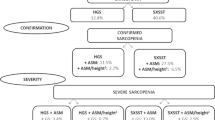Abstract
Background
The methods used in the diagnosis and screening of sarcopenia are not available everywhere. There is a need for more practical tests that can be used especially in the first step.
Aims
We aimed to investigate the usability of blink rate as an alternative test for dynapenia screening.
Methods
A total of 355 patients ≥ 65 years of age (254 (71.50%) female and 101 (28.50%) male) who were admitted to geriatric outpatient clinic were included in this prospective cross-sectional study.
Results
Blink rate was positively correlated with grip strength and negatively correlated with SARC-F. Also, it was found that the blink rate was associated with dynapenia independent of other factors. The optimal cut-off value of 15 s blink rate to predict dynapenia was measured as ≤ 40.5, with 70.3% sensitivity and 43.3% specificity.
Conclusion
Our study indicated the relationship between blink rate with dynapenia and grip strength. Especially in patients with limited mobilization and where it is not possible to reach the hand dynamometer to measure grip strength, the blink rate can be used as an alternative test to detect dynapenia.

Similar content being viewed by others
References
Santilli V, Bernetti A, Mangone M et al (2004) Clinical definition of sarcopenia. Clin Cases Miner Bone Metab 11(3):177–180
Beaudart C, Zaaria M, Pasleau F et al (2017) Health outcomes of sarcopenia: a systematic review and meta-analysis. PLoS One 12(1):e0169548
Hida T, Imagama S, Ando K et al (2018) Sarcopenia and physical function are associated with inflammation and arteriosclerosis in community-dwelling people: the Yakumo study. Mod Rheumatol 28(2):345–350
Mayhew AJ, Amog K, Phillips S et al (2019) The prevalence of sarcopenia in community-dwelling older adults, an exploration of differences between studies and within definitions: a systematic review and meta-analyses. Age Ageing 48(1):48–56
Shaw SC, Dennison EM, Cooper C (2017) Epidemiology of sarcopenia: determinants throughout the lifecourse. Calcif Tissue Int 101(3):229–247
Yoowannakul S, Tangvoraphonkchai K, Vongsanim S et al (2018) Differences in the prevalence of sarcopenia in haemodialysis patients: the effects of gender and ethnicity. J Hum Nutr Diet 31(5):689–696
Cruz-Jentoft AJ, Bahat G, Bauer J et al (2019) Sarcopenia: revised European consensus on definition and diagnosis. Age Ageing 48(1):16–31
Kim JC, Lee SU, Jung SH et al (2019) Natural aging course of paraspinal muscle and back extensor strength in community-dwelling older adults (sarcopenia of spine, SarcoSpine): a prospective cohort study protocol. BMJ Open 9(9):e032443
Clark BC, Manini TM (2012) What is dynapenia? Nutrition 28(5):495–503
Whitney DG, Peterson MD (2019) The association between differing grip strength measures and mortality and cerebrovascular event in older adults: National Health and Aging Trends Study. Front Physiol 9:1871
Tessier AJ, Wing SS, Rahme E et al (2019) Physical function-derived cut-points for the diagnosis of sarcopenia and dynapenia from the Canadian longitudinal study on aging. J Cachexia Sarcopenia Muscle 10(5):985–999
Cochran ML, Czyz CN (2019) Anatomy, head and neck, eyelid. StatPearls Publishing, In
Merkies K, Ready C, Farkas L et al (2019) Eye blink rates and eyelid twitches as a non-invasive measure of stress in the domestic horse. Animals (Basel) 9(8)
Schaefer DP (2007) The graded levator hinge procedure for the correction of upper eyelid retraction (an American Ophthalmological Society thesis). Trans Am Ophthalmol Soc 105:481–512
Arik G, Varan HD, Yavuz BB et al (2015) Validation of Katz index of independence in activities of daily living in Turkish older adults. Arch Gerontol Geriatr 61(3):344–350
Lawton MP, Brody EM (1969) Assessment of older people: self-maintaining and instrumental activities of daily living. Gerontologist 9(3):179–186
Sarikaya D, Halil M, Kuyumcu ME et al (2015) Mini nutritional assessment test long and short form are valid screening tools in Turkish older adults. Arch Gerontol Geriatr 61(1):56–60
Babacan-Yıldız G, Ur-Özçelik E, Kolukısa M et al (2016) Validity and reliability studies of modified mini mental state examination (MMSE-E) For Turkish illiterate patients with diagnosis of Alzheimer disease. Turk Psikiyatri Derg 27(1):41–46
Bahat G, Yilmaz O, Kılıç C et al (2018) Performance of SARC-F in regard to sarcopenia definitions, muscle mass and functional measures. J Nutr Health Aging 22(8):898–903
Bahat G, Tufan A, Tufan F et al (2016) Cut-off points to identify sarcopenia according to European Working Group on Sarcopenia in Older People (EWGSOP) definition. Clin Nutr 35(6):1557–1563
McCormick R, Vasilaki A (2018) Age-related changes in skeletal muscle: changes to life-style as a therapy. Biogerontology 19(6):519–536
Availability of data and materials
There is no available data and material.
Funding
This research received no specific grant from any funding agency in the public, commercial, or not-for-profit sectors.
Author information
Authors and Affiliations
Contributions
Study concept and design: Remzi Bahşi, Murat Varlı, Sevgi Aras
Acquisition of subjects and/or data: Remzi Bahşi, Volkan Atmış, Çağlar Coşarderelioğlu, Hande Selvi Öztorun, Deniz Mut Sürmeli, Tuğba Turgut
Analysis and interpretation of data: Remzi Bahşi, Ahmet Yalçın
Preparation of manuscript: Remzi Bahşi
Corresponding author
Ethics declarations
Ethics approval
This study was approved by the institutional ethical board of Ankara University and was conducted in compliance with the Declaration of Helsinki.
Consent to participate
Informed consent was obtained from all individual participants included in the study.
Conflicts of interest
The authors have no conflicts of interest.
Consent for publication
Informed consent was obtained from all individual participants included in the study.
Code availability
There is no available code.
Additional information
Publisher’s note
Springer Nature remains neutral with regard to jurisdictional claims in published maps and institutional affiliations.
Rights and permissions
About this article
Cite this article
Bahşi, R., Atmiş, V., Coşarderelioğlu, C. et al. A new easily accessible and practical method for dynapenia screening: blink rate. Ir J Med Sci 190, 1619–1623 (2021). https://doi.org/10.1007/s11845-020-02454-6
Received:
Accepted:
Published:
Issue Date:
DOI: https://doi.org/10.1007/s11845-020-02454-6



